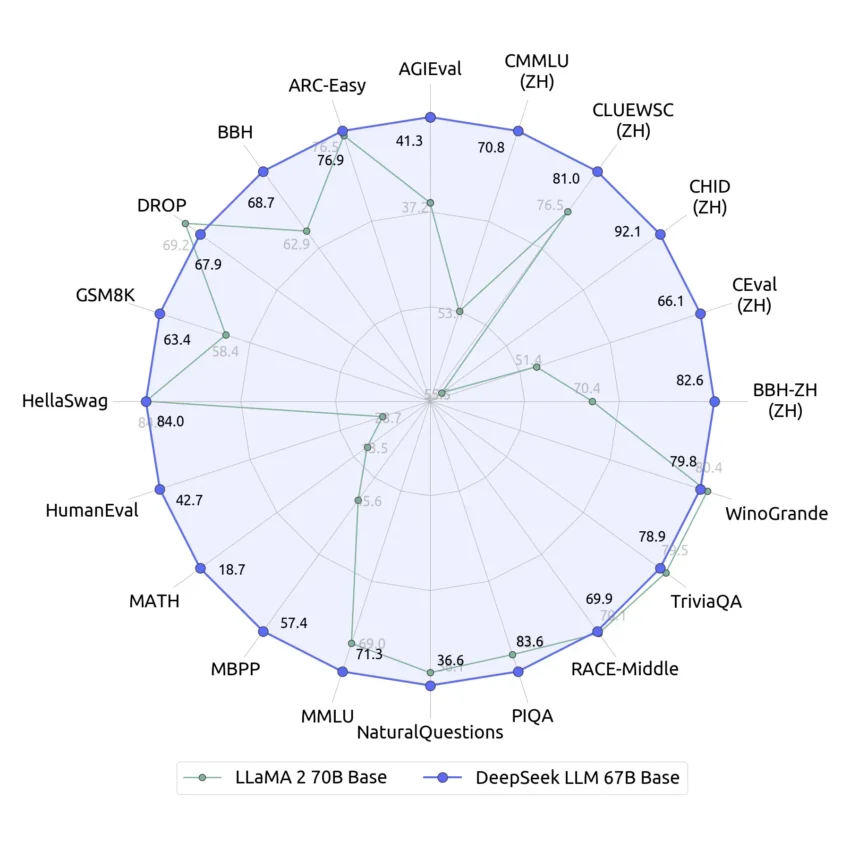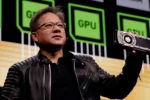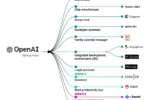OpenAI’s AI race with DeepSeek has become a focal point in the ongoing competition for dominance in artificial intelligence. As OpenAI strives to maintain its position, it faces increasing pressure from competitors, particularly from Chinese firms like DeepSeek, who are accused of appropriating OpenAI’s intellectual property. This rivalry has intensified discussions about OpenAI’s open sourcing strategy, with CEO Sam Altman acknowledging that DeepSeek has narrowed the gap in AI advancements. Altman’s remarks highlight a sense of urgency within OpenAI to innovate, especially with ChatGPT pricing being a topic of concern for users. As the landscape shifts, the implications of recursive self-improvement AI and transparency in model reasoning are becoming critical factors in determining the future of AI development.
The competition in the artificial intelligence sector is heating up as OpenAI finds itself in a challenging position against contenders like DeepSeek AI. This skirmish has sparked significant OpenAI news, particularly regarding the company’s approach to technology sharing and development. Discussions surrounding the pricing of ChatGPT and the potential for more open-source initiatives are gaining traction, with industry experts weighing in on the need for transparency in AI models. Moreover, the concept of recursive self-improvement AI raises questions about the capabilities and ethical considerations of these evolving technologies. As both companies vie for supremacy, the strategies they employ will undoubtedly shape the future of AI innovation.
OpenAI’s Perception of the AI Race Against DeepSeek
OpenAI is navigating a complex landscape as it faces increasing competition from DeepSeek, a Chinese AI company that has rapidly advanced in the AI race. This perception of losing ground has raised eyebrows and led to serious discussions within OpenAI about their current strategies. CEO Sam Altman has openly acknowledged that DeepSeek has significantly narrowed the gap in AI development, which has prompted the organization to rethink its approach to open sourcing and intellectual property management. The stakes are high, and the pressure is mounting to maintain a competitive edge in this fast-evolving industry.
The competition with DeepSeek is not just about technological superiority; it also involves safeguarding proprietary information that OpenAI believes may have been compromised. As OpenAI strives to strengthen its ties with the U.S. government, it’s crucial for the organization to articulate a clear and forward-thinking strategy that addresses both competitive threats and the ethical implications of AI development. This dynamic highlights the importance of transparency and collaboration in the AI landscape, particularly as companies deal with the challenges of trust and credibility.
OpenAI’s Evolving Open Sourcing Strategy
Historically, OpenAI has favored a closed-source model for its development projects, primarily to protect its innovations and maintain a competitive edge. However, as highlighted by Altman, the company is now reconsidering its open sourcing strategy, especially in light of the competitive pressures from DeepSeek. The acknowledgment of needing a ‘different open-source strategy’ reflects a significant shift in thinking within OpenAI, as they assess how to better align with the evolving demands of the AI community and market.
Kevin Weil, OpenAI’s chief product officer, has indicated that the company might consider open-sourcing older models that are no longer at the forefront of AI technology. This potential shift towards open sourcing could foster a more collaborative environment and allow developers and researchers to build upon OpenAI’s foundational work. Striking the right balance between proprietary development and open collaboration will be essential for OpenAI to sustain its leadership position in the competitive AI landscape.
The Future of ChatGPT Pricing and Accessibility
As OpenAI continues to refine its offerings, there has been speculation about potential price increases for the ChatGPT platform. However, Altman has expressed a commitment to making ChatGPT more accessible over time, suggesting that the company is aware of the importance of affordability in attracting and retaining users. Currently, the premium ChatGPT Pro plan, priced at $200 per month, raises questions about sustainability given OpenAI’s operating losses associated with this tier.
The challenge lies in balancing the costs of developing increasingly sophisticated AI models with the need to keep services financially viable for users. Altman’s vision for a cheaper ChatGPT reflects an understanding of market dynamics and user expectations. As competition heats up, particularly with companies like DeepSeek making strides in AI development, OpenAI will need to ensure its pricing strategy aligns with both user needs and the financial realities of operating a cutting-edge tech organization.
AI Models and Recursive Self-Improvement
The concept of recursive self-improvement in AI is gaining traction, particularly as OpenAI explores the implications of its powerful models. Altman has indicated that the likelihood of a ‘fast takeoff’ in AI capabilities is more plausible than previously thought. This development raises critical questions about the potential for AI systems to autonomously enhance their intelligence and capabilities without human intervention, which poses both exciting possibilities and profound risks.
As OpenAI delves deeper into the realm of recursive self-improvement, it is imperative to consider the ethical implications and safeguards necessary to prevent unintended consequences. The partnership with the U.S. government for nuclear defense research underscores the need for responsible AI development, particularly as the capabilities of these models grow. Ensuring that AI remains a tool for constructive progress rather than a vehicle for destructive applications will be a key challenge for OpenAI and the broader AI community.
OpenAI’s Response to Competition and Collaboration
In response to competitive pressures, OpenAI is not just focusing on its internal strategies but also considering how collaborations can enhance its positioning in the AI race. The growing influence of competitors like DeepSeek has prompted OpenAI to engage more openly with external stakeholders, including government entities and research institutions. By fostering these relationships, OpenAI aims to leverage collective expertise and resources to bolster its innovation efforts.
Moreover, Altman’s remarks about potentially revealing more of OpenAI’s reasoning processes highlight a shift towards transparency that could benefit both users and developers. By making the inner workings of AI models more accessible, OpenAI can cultivate a sense of trust and community within the AI ecosystem. This collaboration-focused approach may prove to be a vital strategy in maintaining a competitive edge against rival companies in the rapidly evolving AI landscape.
The Importance of Data Centers in OpenAI’s Strategy
OpenAI’s ambitious data center project, known as Stargate, is a crucial component of its strategy to enhance computational capabilities and model performance. As demand for AI services continues to grow, the need for robust infrastructure becomes even more pressing. Weil emphasized that increased compute power translates to better, more efficient models, indicating that OpenAI recognizes the direct correlation between infrastructure investment and technological advancement.
The Stargate project not only aims to meet the immediate demands of a growing user base but also positions OpenAI for future challenges in the competitive AI landscape. By investing in state-of-the-art data centers, OpenAI can ensure that its models are not only capable of handling current workloads but are also scalable for future growth. This proactive approach to data infrastructure is vital for sustaining innovation and maintaining leadership in an increasingly crowded market.
Navigating Ethical Considerations in AI Development
As OpenAI advances its technologies, ethical considerations remain at the forefront of discussions within the organization. The partnership with the U.S. government for research in nuclear defense exemplifies the delicate balance that AI developers must strike between leveraging powerful technologies for national security and ensuring they are not misused. Altman’s trust in government scientists reflects a belief in responsible AI usage, but it also raises questions about accountability and oversight.
OpenAI’s emphasis on ethical AI development is crucial, especially as the potential for AI applications expands. Ensuring that models like ChatGPT and others are used for beneficial purposes rather than destructive ones is a responsibility that falls on developers, policymakers, and the broader community. As these discussions evolve, OpenAI will need to navigate complex ethical landscapes to foster trust and collaboration among stakeholders.
The Role of User Feedback in AI Model Development
User feedback is an essential component of OpenAI’s model development process, as it provides valuable insights into the effectiveness and usability of AI systems. Altman’s acknowledgment of user preferences regarding the transparency of reasoning processes indicates that OpenAI is committed to listening to its user base. This approach not only helps to refine existing models but also shapes the direction of future innovations.
By integrating user feedback into its development strategy, OpenAI can create models that are more aligned with user needs and expectations. This collaborative relationship between developers and users fosters a sense of community and encourages ongoing dialogue about the capabilities and limitations of AI technologies. In an age where user engagement is paramount, OpenAI’s responsiveness to feedback could be a significant differentiator in the competitive landscape.
Looking Ahead: Future Developments at OpenAI
As OpenAI continues to innovate, there are numerous developments on the horizon that promise to reshape the AI landscape. The anticipated release of the o3 reasoning model and the next flagship GPT-5 model are just a few of the exciting projects in the pipeline. Altman’s comments suggest that OpenAI is committed to delivering cutting-edge technologies that push the boundaries of what AI can achieve.
Moreover, the potential follow-up to DALL-E 3 highlights the rapid advancements being made in image generation technologies. As the AI field evolves, OpenAI must stay at the forefront of these changes to maintain its competitive edge. By continuously pushing the envelope on AI capabilities, OpenAI aims to establish itself as a leader not just in technology but also in responsible and ethical AI development.
Frequently Asked Questions
What is OpenAI’s current position in the AI race with DeepSeek?
OpenAI is contending with the perception that it is losing ground in the AI race to DeepSeek, a Chinese company. OpenAI’s CEO, Sam Altman, acknowledges that DeepSeek has reduced OpenAI’s lead in AI technology, prompting a reassessment of their strategies and development approaches.
How is OpenAI addressing concerns about DeepSeek potentially stealing its intellectual property?
OpenAI has raised concerns regarding DeepSeek’s potential theft of its intellectual property. To combat this, OpenAI is focusing on strengthening ties with U.S. policymakers and exploring an ambitious data center project to enhance its capabilities and protect its innovations.
What changes is OpenAI considering for its open sourcing strategy in light of competition from DeepSeek?
In response to competition from DeepSeek, OpenAI is reevaluating its open sourcing strategy. CEO Sam Altman has indicated a need for a different approach, suggesting that OpenAI may consider releasing older models that are no longer state-of-the-art to remain competitive.
Will ChatGPT pricing increase in the future due to competition with DeepSeek?
OpenAI has attempted to quell rumors of price increases for ChatGPT. Sam Altman expressed a desire to make ChatGPT more affordable over time, despite concerns about operating at a loss with the premium ChatGPT Pro plan.
What is recursive self-improvement AI and how does it relate to OpenAI and DeepSeek?
Recursive self-improvement AI refers to AI systems that enhance their own intelligence autonomously. Sam Altman has suggested that the possibility of a ‘fast takeoff’ in AI capabilities is more plausible now, indicating that advancements from both OpenAI and DeepSeek may lead to significant developments in this area.
How is OpenAI’s Stargate project linked to its competition with DeepSeek?
The Stargate project, OpenAI’s ambitious data center initiative, is designed to meet the growing compute demand driven by an expanding user base. This project is also crucial for maintaining OpenAI’s competitive edge against rivals like DeepSeek.
What are the implications of OpenAI’s partnership with the U.S. government for nuclear defense research?
OpenAI’s partnership with the U.S. government aims to provide its AI models for nuclear defense research, which raises concerns about the application of AI in sensitive areas. However, OpenAI’s leadership expresses confidence that government scientists will responsibly handle the technology.
When can we expect the release of new reasoning models from OpenAI?
Sam Altman indicated that the next reasoning model, o3, is expected to be released in a timeframe of ‘more than a few weeks, less than a few months,’ reflecting OpenAI’s ongoing commitment to advancing its AI capabilities.
What is the status of OpenAI’s future flagship models like GPT-5?
As of now, OpenAI does not have a specific timeline for the release of GPT-5, its next flagship ‘non-reasoning’ model. The company is focused on ongoing improvements and innovations amidst growing competition.
Is OpenAI planning to update its image-generating model, DALL-E 3?
Yes, OpenAI is actively working on a successor to DALL-E 3, as the current model has become outdated. The team is committed to developing a new version that incorporates the latest advancements in image generation technology.
| Key Point | Description |
|---|---|
| OpenAI’s Current Challenge | OpenAI is perceived to be losing its lead in the AI race to DeepSeek, amid allegations of intellectual property theft. |
| Shift Towards Open-Source | Altman emphasizes a need for a revised open-source strategy, although it’s not currently a priority. |
| Release Philosophy Reevaluation | OpenAI may open-source older models and disclose more reasoning processes to enhance transparency. |
| Cost of ChatGPT | Altman aims to make ChatGPT cheaper over time despite operating at a loss with its plans. |
| Compute Power and Model Efficiency | Increased compute power is tied to better models, driving projects like Stargate. |
| Recursive Self-Improvement Possibility | Altman finds the idea of AI models improving themselves without human help increasingly plausible. |
| Collaboration with U.S. Government | OpenAI partners with the U.S. government for nuclear defense research, asserting trust in scientific oversight. |
| Upcoming Model Releases | OpenAI is working on new reasoning and image generation models, with timelines yet to be finalized. |
Summary
OpenAI’s AI race with DeepSeek highlights the competitive landscape of artificial intelligence development. As OpenAI grapples with its perception of losing ground to Chinese competitors, the company is re-evaluating its strategies, particularly concerning openness and transparency in its model development. The leadership acknowledges the need for a shift towards open-sourcing older models and disclosing more about their reasoning processes to maintain relevance and trust. Additionally, OpenAI aims to make its services more accessible while continuing to innovate through increased computational power. As the AI race progresses, the focus on collaboration, responsible use of technology, and ongoing development of advanced models will be crucial for OpenAI to regain its competitive edge.






